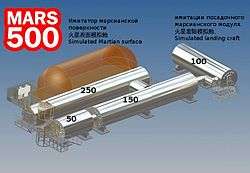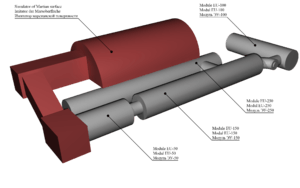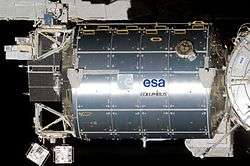MARS-500


The Mars-500 mission was a psychosocial isolation experiment conducted between 2007 and 2011 by Russia, the European Space Agency and China, in preparation for an unspecified future manned spaceflight to the planet Mars.[1] The experiment's facility was located at the Russian Academy of Sciences' Institute of Biomedical Problems (IBMP) in Moscow, Russia.[1]
Between 2007 and 2011, three different crews of volunteers lived and worked in a mock-up spacecraft at IBMP. The final stage of the experiment, which was intended to simulate a 520-day manned mission, was conducted by an all-male crew consisting of three Russians (Alexey Sitev, Sukhrob Kamolov, Alexander Smoleevskij), a Frenchman (Romain Charles), an Italian (Diego Urbina) and a Chinese citizen (Yue Wang). The mock-up facility simulated an Earth-Mars shuttle spacecraft, an ascent-descent craft, and the Martian surface. The volunteers who participated in the three stages included professionals with experience in engineering, medicine, biology, and human spaceflight. The experiment yielded important data on the physiological, social and psychological effects of long-term close-quarters isolation.
Project overview
Purpose
The experiment was intended to yield valuable psychological and medical data on the effects of the planned long-term deep space mission. The experiment permitted the study of the technical challenges, work capability of crew and management of long-distance spaceflight. Communications lag, autonomy, resource rationing, health, conditions of isolation and hermetically closed, confined environment are the main peculiarities of the martian flight.
Scientific objectives
The experiment was designed to allow planning the methods and means of control and monitoring of the habitat during lengthy crew stays in confined and cramped conditions. Planning diagnostic, forecast and treatment of medical support and prophylaxis, the use of telemedicine technologies, countermeasures against adverse effect of the "flight" factors on the human body, psychological support, and the creation of a reporting system for activity of the crew and electronic transfer of information. Methods of psychological support and approbation, using the sociomapping method.[2]
Experiment stages
A total of 640 experiment days were scheduled between 2007 and 2011, divided into three stages of differing length. During each stage, the crew of volunteers lived and worked in a mockup spacecraft. Communication with the outside world was limited, and was conducted with a realistic time delay of up to 25 minutes, to simulate the real-life communications lag between Mars and Earth. Similarly, a realistically limited supply of on-board consumables was provided for the volunteers.[3] Some conditions, such as weightlessness and cosmic radiation, could not be simulated.
The first fifteen-day stage of the Mars-500 experiment took place from 15 November 2007 to 27 November 2007.[4] The purpose of this stage was to test the technical equipment, facilities, and operating procedures for the voyage.[5]
The second, 105-day stage of the Mars-500 experiment began on 31 March 2009 when six volunteers started living in the experiment's isolated living complex.[6] On 14 July 2009, this stage of the experiment was completed.
The 520-day final stage of the experiment, which was intended to simulate a full-length manned mission, began on 3 June 2010 and ended on 4 November 2011.[7][8][9] This stage was conducted by a six-man international crew, consisting of three Russians, a Frenchman, an Italian/ Colombian and a Chinese citizen.[9] The stage included a simulation of a manned Mars landing, with three simulated Mars-walks carried out on the 14th, 18th and 22 February 2011.[10][11] The experiment ended on 4 November 2011, with all the participants reportedly in optimal physical and psychological condition.[9]
In January 2013, the Proceedings of the National Academy of Sciences reported that four of the six crew members had considerable problems sleeping, and some avoided exercise and would hide away from the others, in behaviour compared to animal hibernation.[12] Also, circadian rhythm of autonomic nervous system activity was dampened during confinement.[13]
Facility

The experiment facility was located on the Institute of Biomedical Problems' site in Moscow. The complex consisted of the isolation facility, the mission operations room, technical facilities, and offices.
The isolation facility consisted of five different modules. Three of the modules – the habitat, utility, and medical modules – simulated the main spacecraft. The fourth module simulated the Martian-lander ship and was connected to the main spacecraft. The fifth module was a simulator of the Martian surface, and is connected to the Martian-lander. The combined volume of the modules was 550 m3 (19,000 cu ft).
The facility included all the necessary equipment for running the experiment. These included communications and control systems, ventilation systems, air and water supplies, electrical installations, sewage systems, air and water quality monitoring and partial recycling systems, medical equipment, fire and other safety monitoring systems, and emergency equipment. The modules were maintained at Earth-normal barometric pressure.[14]
Habitable module
The habitable module was the main living quarters for the crew. The cylindrical 3.6 m × 20 m (12 ft × 66 ft) module consisted of six individual crew compartments, a kitchen/dining room, a living room, the main control room, and a toilet. The individual bedroom compartments, which had an area of approximately 3 m2 (32 sq ft) each, contained a bed, a desk, a chair and shelves for personal belongings.[15]
Medical module

The cylindrical medical module measured 3.2 m × 11.9 m (10 ft × 39 ft) and housed two medical berths, a toilet, and equipment for routine medical examinations. It also contained equipment for telemedical, laboratory, and diagnostic investigations. If a crew-member had become ill, they would have been isolated and treated in the module.[14]
Mars landing module simulator
The Mars landing module simulator was only used during the 30-day "Mars-orbiting" phase of the experiment. The 6.3 m × 6.17 m (20.7 ft × 20.2 ft) cylindrical module accommodated up to three crew members, and had three bunk beds, two workstations and a toilet. Its ancillary systems included a control and data collection system, a video control and communications system, a gas analysis system, an air-conditioning and ventilation system, a sewage system and water supply, and a fire-suppression system.[14]
Storage module
The cylindrical 3.9 m × 24 m (13 ft × 79 ft) storage module was divided into four compartments:[14]
- A refrigerated compartment for food storage
- A compartment for storage of non-perishable food
- An experimental greenhouse
- A compartment containing a bathroom, sauna, and gym
Crew
Advertised volunteer requirements
The MARS-500 project posted a number of basic requirements for any potential candidates. These are:
- Age: 25–50 years old
- Higher education
- Professional requirements:
- general practitioner having skills of first medical aid
- physician-investigator having skills of clinical laboratory diagnostics
- biologist
- engineer – specialist in life support systems
- engineer – specialist in computer science
- engineer – specialist in electronics
- engineer – mechanic
- Language skills: knowledge of the Russian and English languages at a professional level
Crew of the first stage
The crew of the first 15-day stage of the isolation experiment was composed of six Russians: five men and a woman.[16] This stage of the experiment was conducted in November 2007.
- Anton Artamonov (born 1982), engineer, physicist and programmer
- Oleg Artemyev (born 1970), engineer and cosmonaut, scheduled in 2011 to fly to the ISS as part of Expedition 39
- Alexander Kovalev (born 1982), engineer employed by IBMP's telemedicine laboratory
- Dmitry Perfilov (born 1975), anesthesiologist employed by IBMP's telemedicine laboratory
- Sergey Ryazansky (born 1974), crew commander, physiologist and cosmonaut
- Marina Tugusheva (born 1983), biologist, IBMP researcher
Marina Tugusheva, the only woman of the crew, was excluded from the longer missions, to prevent sexual tension from jeopardising the mission.[17]
Crew of the second stage
The 105-day second stage involved a crew of six members, and ended on 14 July 2009.[18]
- Oleg Artemyev, Russian cosmonaut
- Alexei Baranov, Russian medical doctor
- Cyrille Fournier, French airline pilot
- Oliver Knickel, mechanical engineer in the German Army
- Sergey Ryazansky (commander), Russian cosmonaut
- Alexei Shpakov, Russian sports physiologist
2nd stage Crew Photo on Russian Wikipedia.
Crew of the third stage
More than 6,000 people from 40 countries applied for the 520-day third stage of the experiment.[19] The selected volunteers were three Russians, two Europeans and one Chinese.[20] They had a varying command of English, but not all spoke Russian.[21]
- Romain Charles, 31-year-old French engineer[22][23]
- Sukhrob Rustamovich Kamolov (Сухроб Рустамович Камолов), Russian surgeon[19][24]
- Alexey Sergeyevich Sitev (Алексей Сергеевич Ситёв), Russian engineer[19] and commander of the mission[25]
- Alexandr Egorovich Smoleevskiy (Александр Егорович Смолеевский), Russian physiologist[19][25]
- Diego Urbina, 27-year-old Italian-Colombian engineer[20]
- Wang Yue (王跃), 27-year-old Chinese instructor at the China Astronaut Research and Training Center[24][26]
The other member of the crew, a replacement, was Mikhail Sinelnikov (Михаил Олегович Синельников), a 37-year-old Russian engineer.[19] The mission started on 3 June 2010[27] and concluded on 4 November 2011, whereupon the participants entered a four-day quarantine before leaving the facility.[9][28]
Satellite experiments
During the MARS 500 experiment related additional experiments aimed at studying the effects of radiation, health problems associated with weightlessness, the impact of fire on board the ship, and others are conducted.[29]
Cardiac experiments
Crew experiments included monthly operational research, consisting of recording electrocardiogram, respiratory samples and blood pressure, and a questionnaire about lifestyle, stress and possible complaints over the past month.
Quarterly dynamic complex studies included measurement and recording of blood pressure and complex cardiorespiratory parameters during the performance of functional tests with physical, mental and orthostatic load. Detailed questionnaires conducting psychological testing and standard outpatient dispensary studies were conducted before and after the series of studies.
Immersion experiments
Because of the long stay in weightlessness, the person gets hypokinetic disorders. To study this phenomenon, IBMP has been conducting research in this area for many years, what allowed to construct a detailed picture of the make hypokinetic disorders. The experimental results show that the main cause of violations was a change in the gravity-dependent mechanisms that are responsible for motoric activity under the influence of gravity on the body. The changes begin to occur because of the disruption of coordinated work of sensory systems, in particular, support and proprioceptive ones. Data obtained during the experiments suggest that the support afferentation in humans acts as a mechanism of activation and regulation of activity of the postural-tonic system, and that the lack of support is the reason for discharge of the physiological and morphological changes that are common in conditions of weightlessness and microgravity.[29]
The main purpose of the immersion experiments are to study effects of the flight, including unloading, on the support mechanisms of the body (spinal, supraspinal), the state of the central nervous systems, motor function and hand-eye co-ordination.[30]
Hyperbaric experiments
During the flight, there is a risk of fire in the spacecraft, and argon is planned as an inhibitor in the ships atmosphere to reduce this risk. The use of argon can significantly reduce the concentration of oxygen in the atmosphere of a spacecraft without any harm to the crew and to create a so-called hypoxic environment. Hyperbaric experiments will complement the knowledge on the effect of fire-resistant oxygen-nitrogen-argon mixture on the human body with the help of an integrated assessment of the subject's body during a long stay in fire-resistant mixture. The tests will determine the level of mental and physical performance, assess the state of the cardiorespiratory system, hematological, metabolic and immunological parameters in blood, and conduct microbiological research and research that will improve existing support systems.[31]
Radiological experiments
To avoid health problems caused by irradiation during the flight to Mars, it is necessary to create a prediction model of radiation risk. The model should describe the risk of radiation sickness depending on the total dose received, decreased performance which causes an acute reaction, and the possible reduction of the overall immune system resistance to the other health risks of interplanetary flight.
The prediction model is created by exposing a group of monkeys to a radiation source (caesium-137). Radiological experiments are then conducted to study the radiobiological reactions of the main regulatory body systems (nervous, endocrine, immune, cardiovascular, hematopoietic), and spermatozoa and cytogenetic response to irradiation and analysis of long-term effects of exposure (life expectancy and carcinogenesis). The experiment uses male rhesus macaque aged 3–5 years. They are divided into groups of 10-15 monkeys in each group. The experiments were designed so that mimic the real exposure of crew during the flight to Mars, including acute and chronic phases of disease.[32]
Study of gastrointestinal tract
Among the space experiments on the medical-biological section of "The long-term program of scientific and applied research and experiments planned for the Russian segment of ISS" planned and put into effect an experiment Splankh: "Study of the structural-functional state of various parts of the gastrointestinal tract to identify the specific changes in the digestive system in a space flight". Within the MARS-500 project the crew did a 24-h electrogastroenterography study electrical activity of gastrointestinal tract using on-board gastroenterograph Splankh-1, developed by IBMP with RPC "Istok-Sistema" based on the mass-produced gastroenterograph Gastroscan-GEM.[33][34][35]
Psychological effects
According to official results, the crew of 520-day isolation underwent the trial as the single unit. There were no conflict situations noted, nor any situations requiring interference of the ground-based services.[36] The difficulties encountered during the performance of some complicated activities were overcome by the crew together. It is worth saying that cultural differences and language difficulties did not bear any significant influence. Friendly and constructive communication is said to have prevailed throughout the experiment. The crew spent enough time together, watching films in different languages, as an opportunity to see and discuss the seen films together. The crew prepared surprises for birthdays, major state holidays and informal holidays (on October 31, they celebrated Halloween). It is possible to notice that the crew members somehow increased the time spent on individual activities, which did not hamper communication. There were no division of the crew along language lines or other interests to be noted. The commander exercised his authority as both a formal and informal leader.
See also
References
- 1 2 В Москве завершилась 520-дневная репетиция полета на Марс
- ↑ "The main purpose of 520-day isolation". Retrieved 2010-06-01.
- ↑ "ESA – Mars500 – Mars500: study overview". Esa.int. 21 May 2010. Retrieved 2010-06-01.
- ↑ "Russia continues flight simulation experiments for Mars-500 | Science | RIA Novosti". En.rian.ru. 6 January 2010. Retrieved 2010-06-01.
- ↑ "Mars500 quick facts". European Space Agency. 21 May 2010. Retrieved 2010-06-02.
- ↑ Schwirtz, Michael (30 March 2009). "Staying Put on Earth, Taking a Step to Mars". The New York Times.
- ↑ Kelly, Jon (1 June 2010). "A space odyssey of the mind". BBC News.
- ↑ Amos, Jonathan (3 June 2010). "Volunteers begin Mars500 isolation". BBC News.
- 1 2 3 4 Amos, Jonathan (4 November 2011). "Simulated Mars mission 'lands' back on Earth". BBC News.
- ↑ Mars-500: a second walk. Roscosmos (in Russian), 18 February 2011. Retrieved 2011-11-04.
- ↑ "Marsonauts" started a third walk on the "surface" of the Red Planet. RIAN (in Russian), 22 February 2011. Retrieved 2011-11-04.
- ↑ "Mars experiment marred by sleep woes". 3 News NZ. 9 January 2013.
- ↑ Vigo, Daniel E.; Tuerlinckx, Francis; Ogrinz, Barbara; Wan, Li; Simonelli, Guido; Bersenev, Evgeny; Van den Bergh, Omer; Aubert, André E. (2013). "Circadian Rhythm of Autonomic Cardiovascular Control During Mars500 Simulated Mission to Mars". Aviation, Space, and Environmental Medicine. 84 (10): 1023–1028. doi:10.3357/ASEM.3612.2013. ISSN 0095-6562.
- 1 2 3 4 "ESA – Mars500 – The isolation facility". Esa.int. 21 May 2010. Retrieved 2010-06-01.
- ↑ "ESA Mars 500 Isolation Study Information Kit" (PDF). Retrieved 2011-02-02.
- ↑ (Russian) Project Mars-500, Состав экипажа 14-суточной изоляции
- ↑ Daily Mail, 'Women excluded from 'Mars mission' crew to prevent sexual tension ruining 105-day voyage', Claire Bates, 2009-03-31.
- ↑ Mission accomplished: 105-day Mars mission simulation ends in Moscow, ESA Portal, 2009-07-14
- 1 2 3 4 5 Russia Picks Space-Pod Team for 520-Day Moscow ‘Voyage’ to Mars, Bloomberg Businessweek, 2010-05-18
- 1 2 Mars 500: Countdown starts for gruelling mission in Moscow car park, The Guardian, 2010-06-02
- ↑ Six Men Get Ready for 520-Day Simulated Mars Trip, ABC News, 2010-05-18
- ↑ Romain Charles, ESA – Mars500
- ↑ Путешествие к Марсу признали скучным занятием
- 1 2 Six Men Get Ready for 520-Day Simulated Mars Trip, ABC News, 2010-05-18, p. 2
- 1 2 He married and left on Mars, Russian News Line, 2010-06-03
- ↑ Chinese Volunteer Wang Yue, China Manned Space Engineering Office – Mars500
- ↑ ESA Mars500 News, ESA – Mars500
- ↑ "Call for media: Mars500, welcome back to Earth". ESA, 10 October 2011. Retrieved 2011-10-24.
- 1 2 Harland, David M.; Harvey, Brian. Space Exploration 2008. Berlin Heidelberg New York: Springer. p. 62. ISBN 978-0-387-71667-1.
- ↑ (Russian) Official website of MARS-500 project. Иммерсионные эксперименты (Immersion experiments).
- ↑ (Russian) Official website of MARS-500 project. Гипербарические эксперименты (Hyperbaric experiments).
- ↑ (Russian) Official website of MARS-500 project. Радиологические эксперименты (Radiological experiments).
- ↑ (Russian) Official website of the Institute of Biomedical Problems RAS. Department of Nutrition, Gastroenterology, and Hygienic Control Physical Environmental Factors.
- ↑ Funcional Gastroenterology, website. Studies of the gastrointestinal tract in the Mars-500 project.
- ↑ Funcional Gastroenterology, website. Studies of the gastrointestinal tract in the simulation of weightlessness by dry immersion.
- ↑ Information at the official site IMBP in Russian
External links
| Wikimedia Commons has media related to Mars-500. |
- Information at the official site IMBP in Russian (up-to-date, more extensive), and in English
- Information at the official ESA site
- Information on Czech scientific participation in the MARS-500 project
- Official project blog
- News report on the end of project with quality photos (Russian)
- Official illustrated report on the end of the 520-day isolation (English)
- Nicolay Kübler about "mars simulation on earth" including Mars 500 (YouTube Video) SpaceUp Stuttgart 2012
- News articles on the project
- Inside the Mars-500 "spaceship", BBC News, 3 March 2008
- Russia continues flight simulation experiments for Mars-500, RIA Novosti, 15 April 2008
- Volunteers flock to space experiment , BBC News, 27 March 2009
- "Cosmonauts" ready for Mars test, BBC News, 22 March 2010

.jpg)

